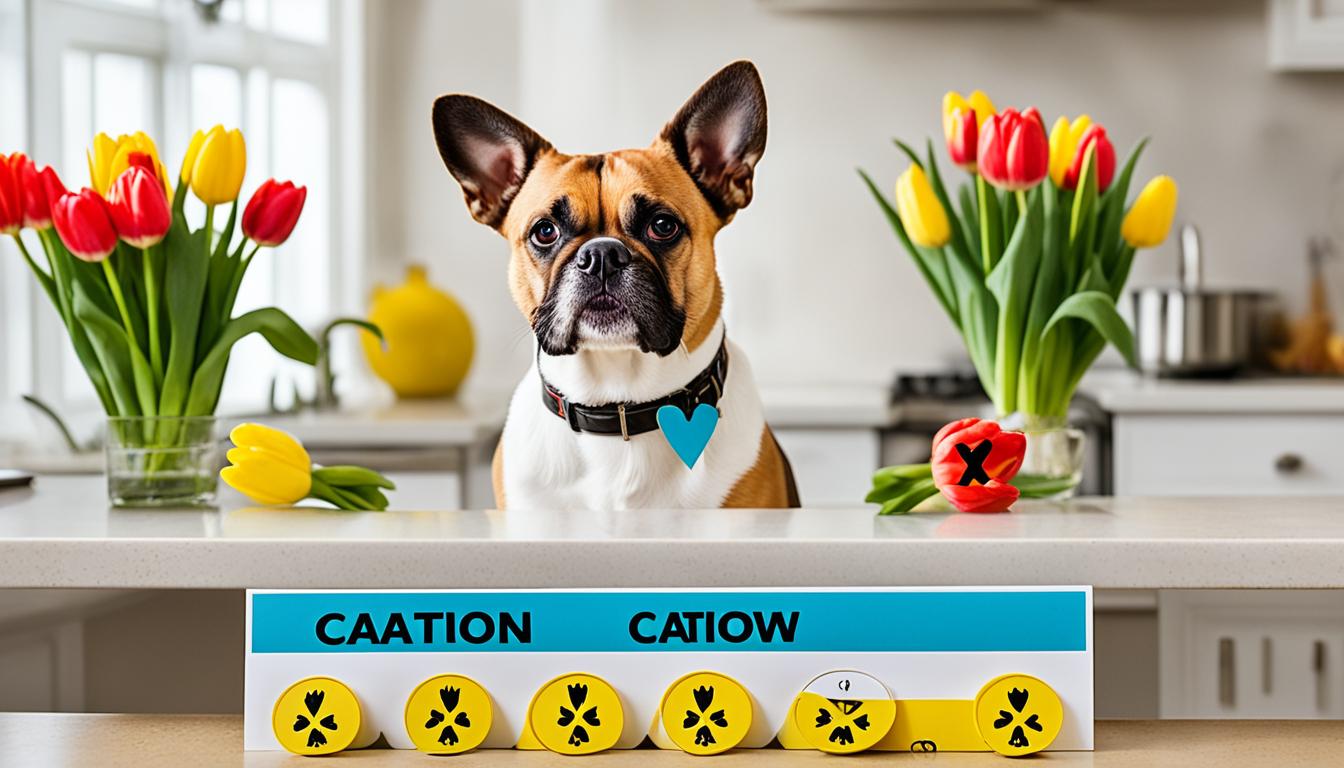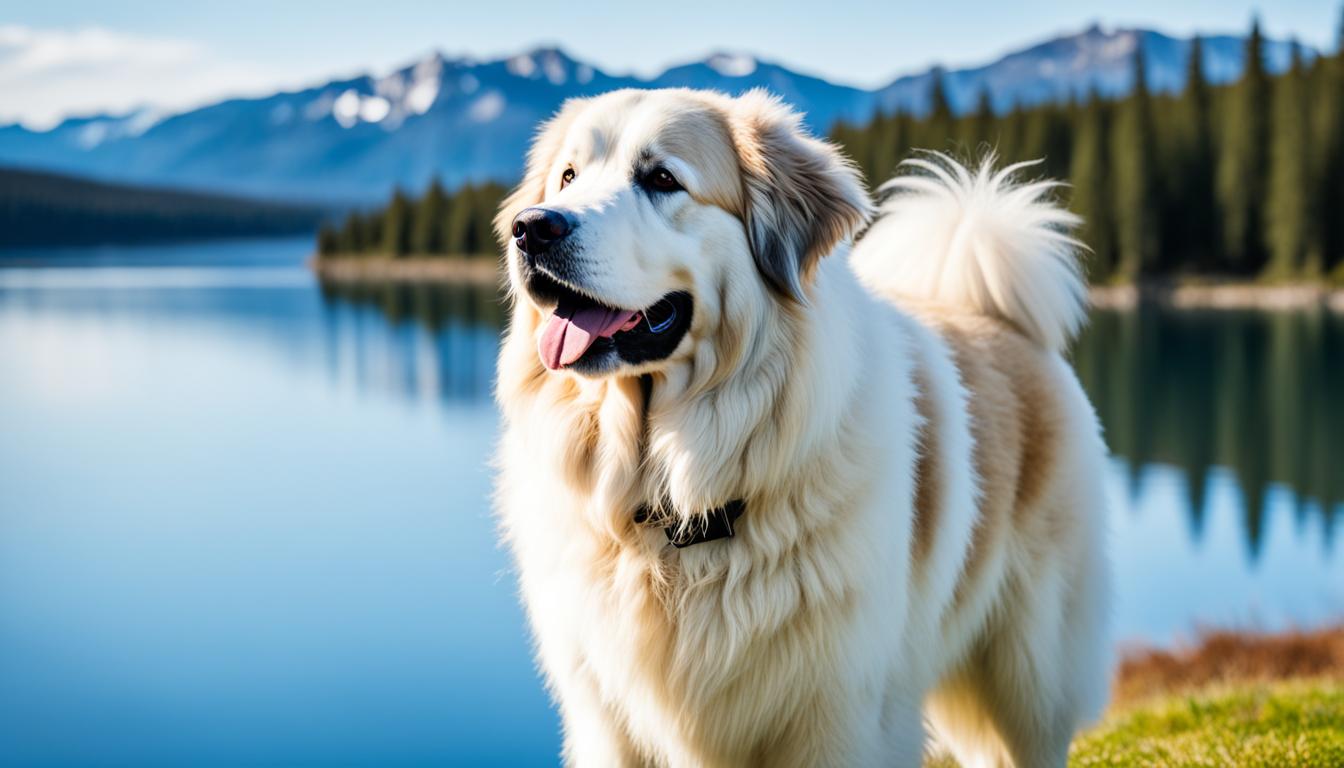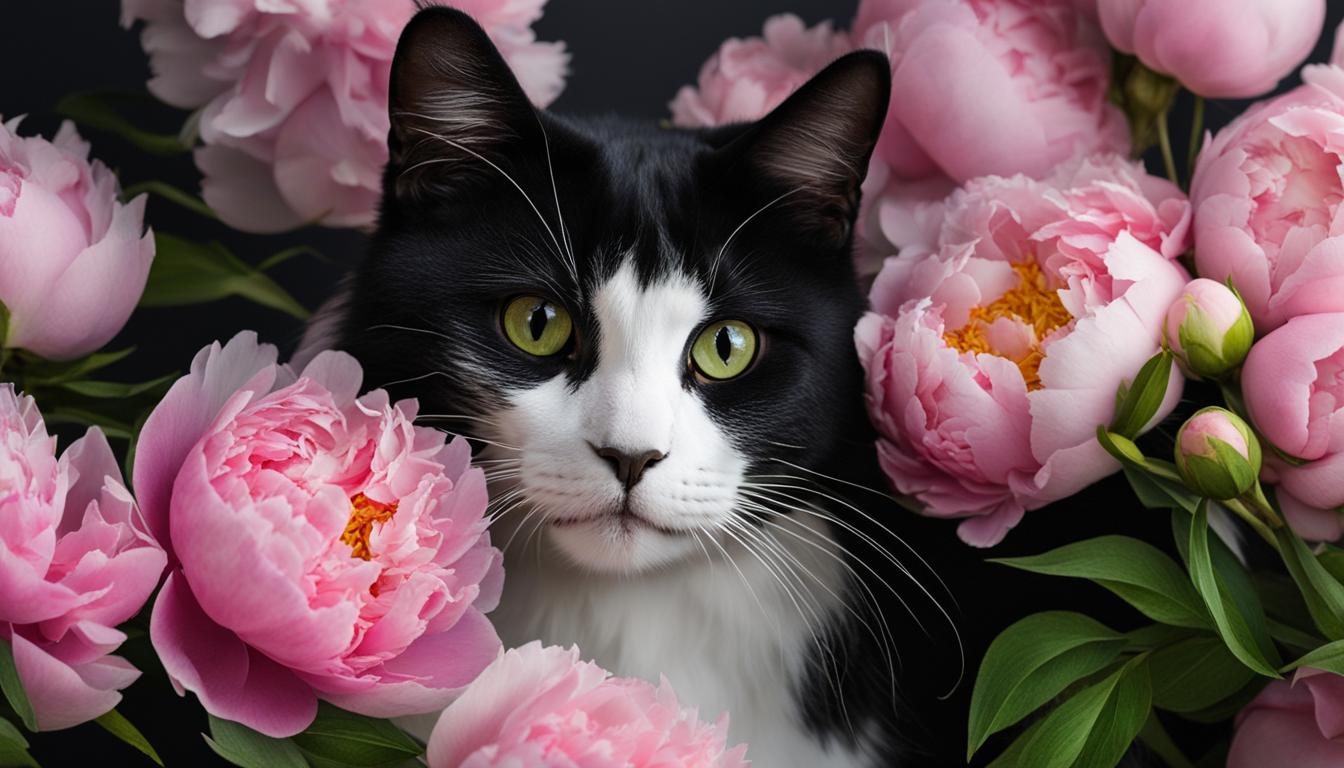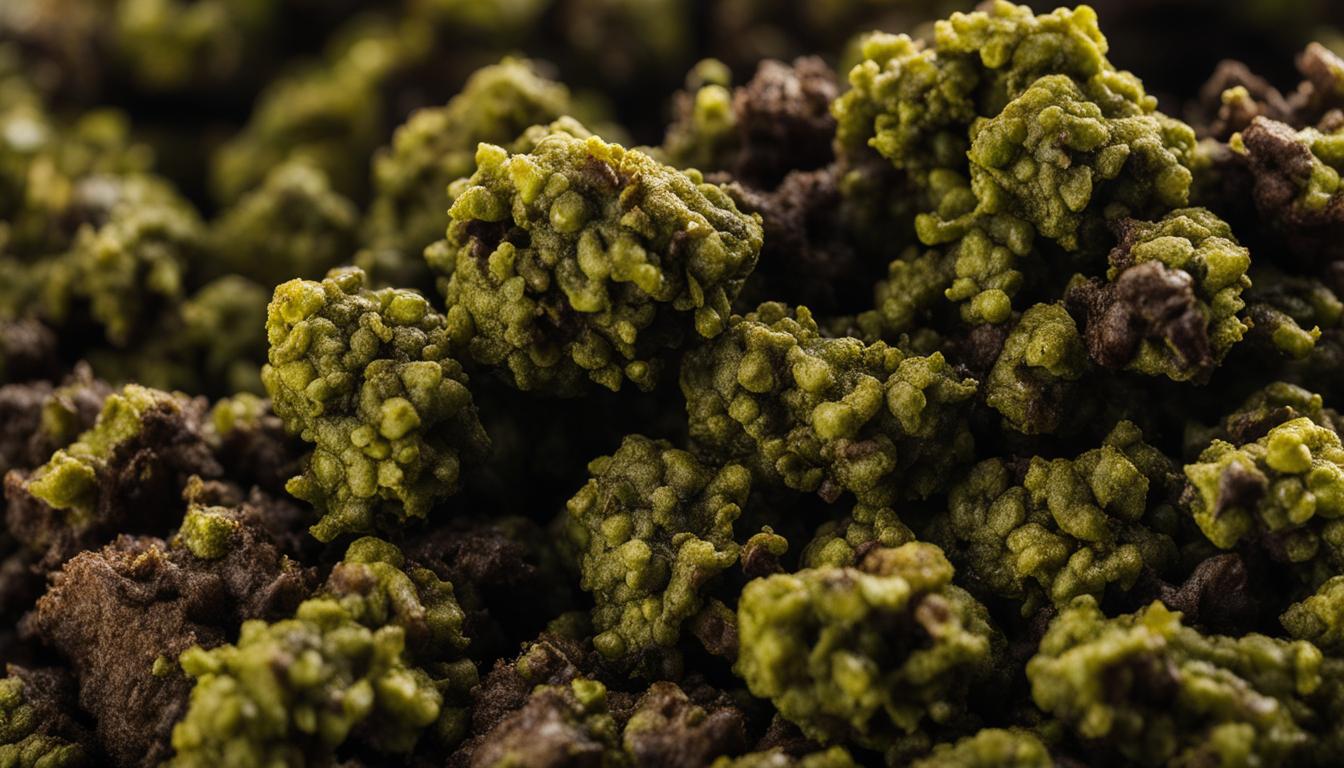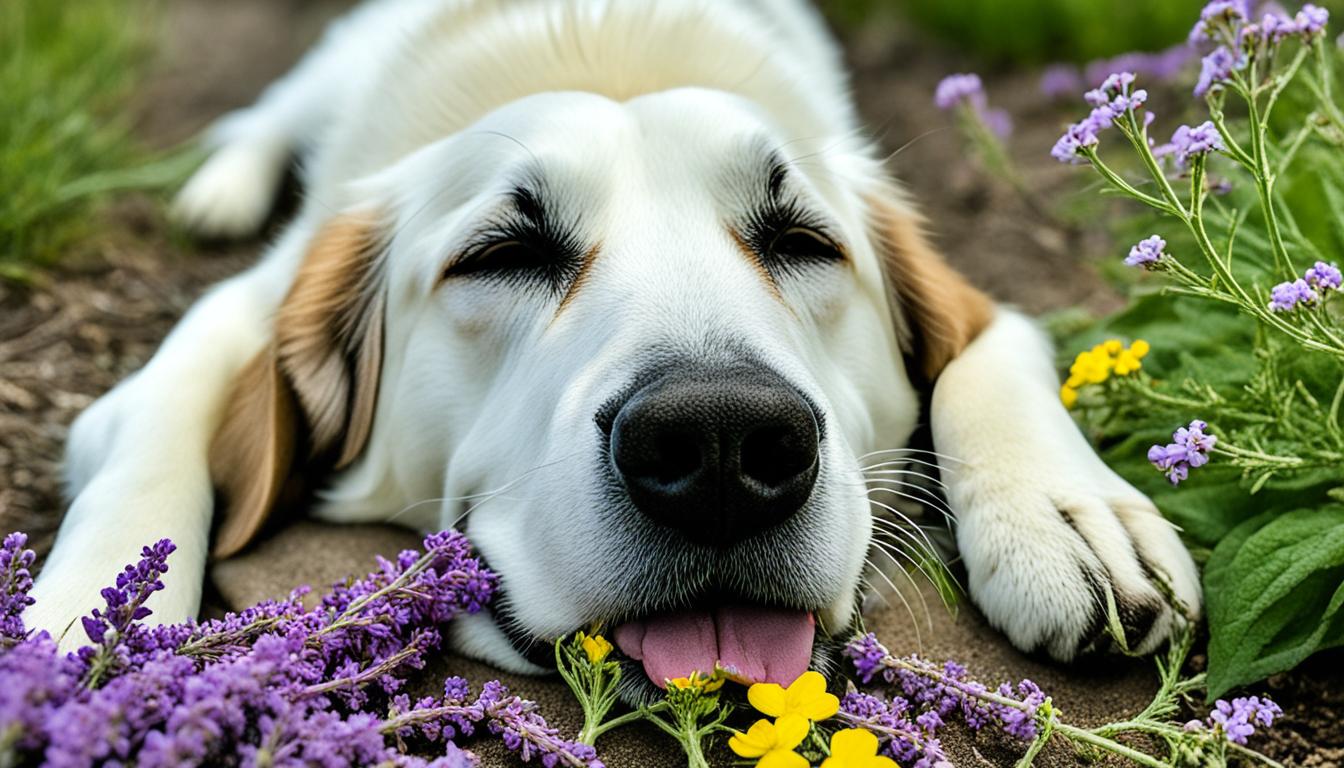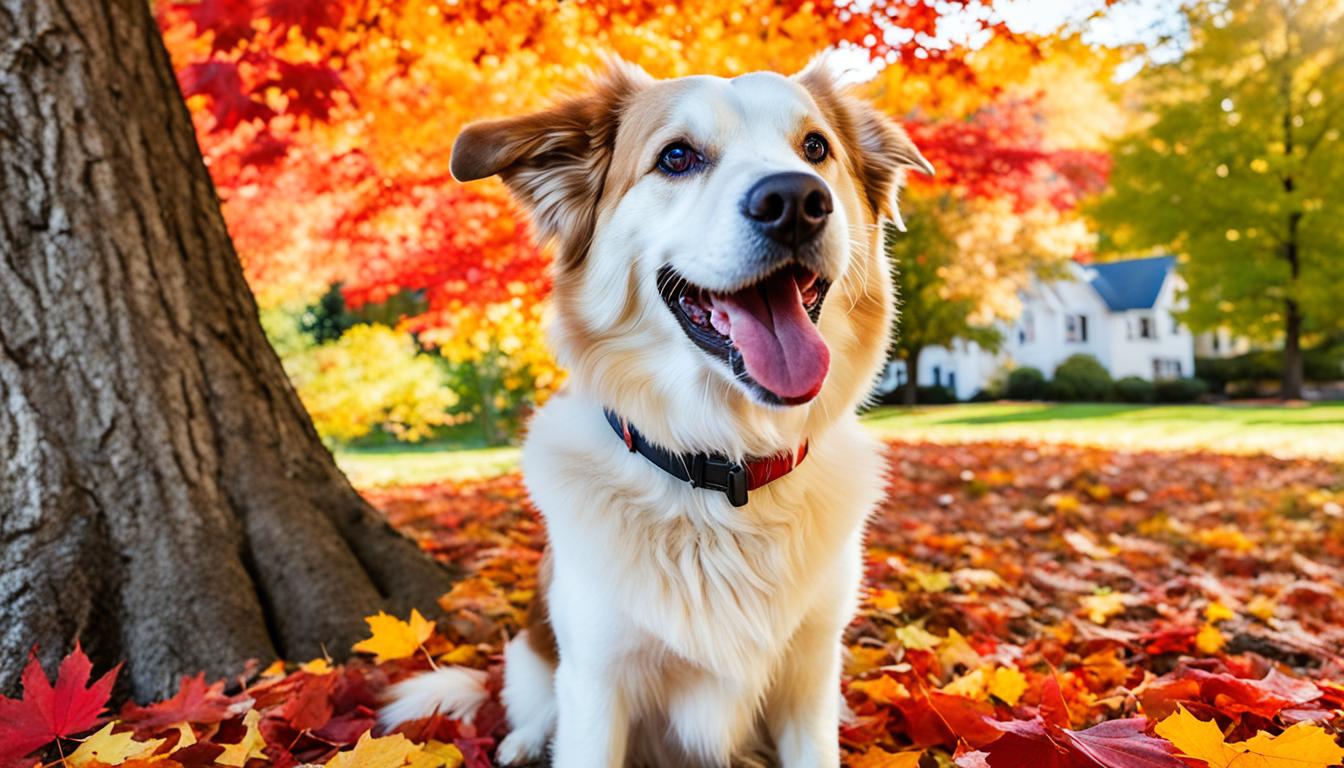Tulips are bright, lovely flowers that make our gardens and homes look great in spring. But if you have a dog, you need to know about the dangers tulip bulbs might pose. Yes, tulip bulbs are poisonous to dogs.
Tulips and other spring flowers like daffodils, crocuses, and amaryllis have harmful stuff in them. The tulip bulb has the most toxins. If a dog eats any part of a tulip, especially the bulb, it can get sick.
Key Takeaways:
- Tulip bulbs are toxic to dogs and can cause various symptoms when ingested.
- The severity of symptoms depends on the amount and part of the plant consumed.
- If you suspect your dog has eaten tulip bulbs, get help from a vet right away.
- Getting advice from a vet is critical for dealing with tulip bulb poisoning in dogs.
- To avoid tulip bulb poisoning, keep tulips and other harmful plants away from your dog.
Symptoms of Tulip Bulb Poisoning in Dogs
Dogs can show different signs if they eat tulip bulbs. How bad these signs are depends on how much and what part of the plant they ate. Some common signs are:
- Vomiting
- Diarrhea
- Drooling
- Dehydration
- Lethargy
- Stomach pain
- Increased heart rate
- Increased respiratory rate
- Difficulty breathing
Sometimes, things get very serious, and dogs might have a hard time breathing. This is when they need a vet right away. A vet will ask about what your dog ate, look for signs, and check your dog carefully.
Quoting Veterinary Expert, Dr. Lily Richards:
“Dogs react to tulip bulb poisoning in different ways. It depends on how much toxin they eat. Be on the lookout for vomiting, diarrhea, and being very tired. If you see these signs, or think your dog ate tulip bulbs, see a vet fast.”
If your dog eats tulip bulbs and shows these signs, seeing a vet is very important. They will check your dog and give the right treatment.
Common Symptoms of Tulip Bulb Poisoning in Dogs
| Symptoms | Description |
|---|---|
| Vomiting | Expulsion of stomach contents through the mouth |
| Diarrhea | Loose, watery feces |
| Drooling | Excessive production of saliva from the mouth |
| Dehydration | Lack of adequate fluid in the body |
| Lethargy | Lack of energy, excessive tiredness |
| Stomach pain | Discomfort or distress in the abdominal area |
| Increased heart rate | Elevated pulse or heartbeat |
| Increased respiratory rate | Rapid breathing or panting |
| Difficulty breathing | Labored or strained respiration |
Veterinarian Advice on Tulip Bulb Ingestion
If you think your dog has eaten tulip bulbs, get veterinary help fast. This is key as vets can quickly figure out what to do. They make sure your dog gets the care it needs to get better from the poisoning.
The vet will look at how bad the symptoms are and what your dog ate. They’ll decide what to do next. They might:
- Make your dog vomit to get rid of toxins.
- Use activated charcoal to stop toxins from spreading.
- Give your dog fluids through an IV to keep them hydrated.
A vet will watch how your dog is doing and plan the next steps. This could mean more tests or changing the treatment. They play a huge part in helping your dog feel better.
“Seeking veterinary advice promptly can significantly increase the chances of a positive outcome for dogs who have ingested tulip bulbs.” – Dr. Sarah Thompson, DVM
Table: Treatment Options for Tulip Bulb Poisoning
| Treatment | Description |
|---|---|
| Inducing Vomiting | Removes any remaining toxins in the stomach through controlled vomiting. |
| Activated Charcoal | Administered to reduce toxin absorption in the intestines, preventing further harm. |
| Supportive Care | Intravenous fluids and other measures to maintain hydration and monitor the dog’s condition. |
Emergency Care for Dogs Who Ate Tulip Bulbs
If your dog ate tulip bulbs and is having trouble breathing, get help fast. Call a vet or the Animal Poison Control Center (APCC) at 888-426-4435 right away. They will tell you what to do next. Quick action is key to helping your dog get better.
Dogs can get very sick from eating tulip bulbs. They might have a hard time breathing. This is very serious. The bad stuff in tulip bulbs causes these problems.
If your dog shows these serious signs, you must act fast. Call a vet or the APCC for advice. They might tell you to take your dog to an emergency vet clinic right away.
Respiratory Distress: A Serious Symptom of Tulip Bulb Poisoning
Respiratory distress means the dog’s breathing system is hurt by tulip bulb poison. Signs include:
- Rapid or labored breathing
- Excessive panting
- Gasping for air
- Wheezing or coughing
- Blue or pale gums and tongue
Seeing any of these signs after tulip bulb eating means you need to get help fast. Waiting can make things much worse for your dog.
“Dogs who have ingested tulip bulbs and are experiencing severe symptoms, such as difficulty breathing or respiratory distress, require immediate medical attention.
Quick help is crucial for dogs with breathing trouble from tulip bulbs. Calling a vet or the APCC gets you the right advice quickly. This can help a lot before you get to the vet.
Tulip bulb poisoning is very serious. Knowing the warning signs like breathing trouble and acting fast can save your dog’s life.
Preventing Tulip Bulb Poisoning in Pets
Keeping your pets safe is important. You can make a safe space for them by following easy steps:
- Keep tulips out of reach: Put tulips and other harmful bulbs where pets can’t get to them. Use high shelves, hanging baskets, or keep them in closed containers.
- Create barriers: Use fences or gates in your garden. This keeps pets away from tulip bulbs and safe.
- Avoid planting toxic bulbs: Choose bulbs that are safe for pets. Staying away from harmful ones protects your furry friends.
- Training and supervision: Teach your pets to stay away from dangerous plants. Always watch them when they are outside to keep them safe.
These steps can lower the chance of your pets getting sick from tulip bulbs. Their safety is up to you!
“By following these steps, you can keep your pets safe from tulip bulb poisoning.” – Veterinarian Lily Richards
Other Plants that are Poisonous for Dogs
Tulips are not the only dangerous plants for dogs. Dog owners must know about other harmful plants. Plants like…
- Rhododendrons
- Oleander
- Morning glory
- Lily of the valley
- Laburnums
These plants can also hurt your dog if eaten. Keep them away from pets to avoid poisoning. Knowing these plants is key to keeping your dog safe.
Use fences to keep your dog away from these plants. If you love gardening, avoid these toxic plants. Training your dog to stay away from them is important too.
“Dog owners should be cautious about the plants they have both indoors and outdoors. Even though dogs can be curious and may explore their surroundings, it’s our responsibility to protect them from potential hazards, including toxic plants.”
Common Symptoms of Plant Poisoning in Dogs
If a dog eats a toxic plant, it might show signs. Some of these signs may include:
- Vomiting
- Diarrhea
- Excessive drooling
- Abdominal pain
- Lethargy
Some dogs might have even worse reactions. These include hard breathing, seizures, or organ failure. If your dog eats something toxic, get vet help right away.
Comparison of Toxic Plants for Dogs
| Plant Name | Symptoms |
|---|---|
| Rhododendrons | Vomiting, drooling, diarrhea, loss of appetite, weakness |
| Oleander | Gastrointestinal symptoms, irregular heartbeat, tremors, seizures |
| Morning Glory | Vomiting, diarrhea, confusion, lethargy, dilated pupils |
| Lily of the Valley | Heart rhythm abnormalities, vomiting, diarrhea, seizures |
| Laburnums | Tremors, seizures, vomiting, diarrhea, weakness |
This table doesn’t list all the dangerous plants for dogs. Always talk to your vet and research safe plants. It helps keep your pets safe.
Veterinary Expert on Tulip Bulb Poisoning
Veterinary expert Lily Richards is a pro vet. She says it’s key to get vet help if your dog ate tulip bulbs. She knows a lot about this and can help your pet. Lily understands that tulip poisoning can be serious. She’s ready to figure out what’s wrong and fix it.
“If your dog has eaten tulip bulbs, see a vet,” Lily Richards advises. “How sick they get can depend on many things. Such as how much they ate and how big they are. Getting a vet’s help is key. With the right care, most dogs get better.”
Lily Richards is a great vet to turn to. She ensures your dog gets the care it needs. She gives advice that fits your dog’s situation. This helps with solving tulip poisoning problems. It’s important to act fast and follow a vet’s advice for your dog to get better.
Meet Veterinarian Lily Richards
| Qualifications | Expertise | Availability |
|---|---|---|
| Doctor of Veterinary Medicine (DVM) | Tulip Bulb Poisoning | Monday-Friday, 9AM-5PM |
| Member of American Veterinary Medical Association | Pet Poisoning Treatment | Emergency Consultations Available |
| Over 10 Years of Veterinary Experience | Plant Toxicity Awareness | Virtual Appointments Offered |
Looking for vet advice on tulip bulb poisoning? Reach out to Lily Richards. She’s an expert in treating pet poisonings and knows about plant dangers. She can guide you in caring for your pet the best way possible.
Diagnosis and Treatment of Tulip Bulb Poisoning
To find out if a dog has tulip bulb poisoning, a vet will check them closely. They will look into how the dog got poisoned, the signs it shows, and do a physical check. They might also test the dog’s blood to see how its organs are doing.
After knowing for sure, the vet can start the right treatment. Making the dog throw up is one way to get rid of the poison. This helps get the tulip bulb out and stops more poison from getting in. They might also give activated charcoal to trap any more poison.
Caring for the dog well is key in getting it better. The vet may give fluids through a vein to keep the dog hydrated and help clean out the poison. They will watch the dog’s heart and breathing closely. In bad cases, the dog might need to stay at the hospital for more help, like oxygen and heart checks.
Different treatments might be needed based on how sick the dog is. So, it’s very important to talk to a vet to figure out the best way to help your dog.
| Treatment Method | Description |
|---|---|
| Induced Emesis | Administration of medication or hydrogen peroxide to induce vomiting, expelling the ingested tulip bulb. |
| Activated Charcoal | Oral administration of activated charcoal to limit further toxin absorption by trapping the toxic compounds. |
| Intravenous Fluids | Administration of fluids directly into the bloodstream to maintain hydration and aid in toxin elimination. |
| Hospitalization | In severe cases, dogs may require hospitalization for continuous monitoring, supportive care, and additional interventions. |
Prevention and Early Intervention
Stopping tulip bulb poisoning is key for your dog’s safety. Make sure tulip bulbs and other harmful plants are away from them. Keep your yard or outside safe from bad plants. Also, watching and training your dog can keep them away from tulips.
“The key to successful treatment is early intervention. If you suspect your dog has ingested tulip bulbs, seek veterinary advice immediately to ensure prompt diagnosis and treatment,” advises Dr. Lily Richards, a renowned veterinarian.
Being careful, acting fast, and getting vet help can protect your pet from tulip bulb poisoning.
Recovery and Prognosis for Tulip Bulb Poisoning
When dogs eat tulip bulbs, how they get better can differ. The dog’s size, age, and health matter a lot. These things affect how they handle the poison.
Most dogs get better from eating tulip bulbs with the right care. Listen to the vet and take good care of your dog. This helps your dog heal.
A vet will watch your dog closely. They will check your dog often. And do tests if needed. This helps catch any problems early on.
Each dog heals in its own way. Be patient and look after your dog well during this time.
If you’re worried about your dog, talk to a vet. Vets know best and can give advice just for your dog. This advice helps your dog heal faster.
Following the vet’s advice helps your dog a lot. It means your dog is more likely to get better.
Prognostic Factors for Tulip Bulb Poisoning Recovery
Some things can change how well a dog gets better after eating tulip bulbs:
- Amount ingested: How sick a dog gets can depend on how much they ate.
- Timeliness of treatment: Getting help fast and following treatment makes a big difference.
- Overall health condition: Dogs with health problems might have a harder time getting better.
- Age and size: Smaller and younger dogs might get sicker from the poison.
These things help us guess how well a dog might recover. Remember, each dog’s situation is different.
| Prognostic Factors | Potential Impact on Recovery |
|---|---|
| Amount ingested | Severity of symptoms and toxicity levels |
| Timeliness of treatment | Effectiveness of intervention and management |
| Overall health condition | Ability to withstand the toxic effects |
| Age and size | Vulnerability to the toxicity of tulip bulbs |
Importance of Pet Safety and Plant Awareness
Your pets’ safety should be your main concern. Love and care are important, but so is knowing about dangers. This includes knowing about toxic plants like tulips.
Keep these plants away from pets to avoid accidents. Pets are curious and might try to taste them. This can keep them safe from eating something harmful.
Learn about which plants are bad for pets. Knowing this helps you make your home safe. This effort can save your pet’s life.
“The safety and well-being of our pets depend on our knowledge and vigilance. By keeping toxic plants out of their reach and educating ourselves about plant toxicity, we can create a safer environment for our furry friends.” – Lily Richards, veterinarian
Make your home safe for pets. Put dangerous plants where pets can’t get to them. Or don’t grow harmful plants at all.
Watch over your pets and teach them well. This helps them stay away from where bad plants are.
Benefits of Pet Safety and Plant Awareness:
- Prevents accidental ingestion of toxic plants
- Reduces the risk of plant-related poisoning
- Helps create a safe environment for your pets
- Increases peace of mind and reduces worry
- Protects your pet’s well-being
Every pet owner must protect their pets. Focus on their safety and knowing about plants. This way, your pets stay safe from harm.
Conclusion
Keeping your pets safe means knowing about dangers like tulip bulbs. Tulips can be harmful to dogs. If they eat them, they might get sick.
It’s super important to think about pet safety and know about risky plants. Being careful can stop pets from getting poisoned. Always keep tulips away from pets and learn about which plants are bad.
If you think your dog ate tulip bulbs, get help from a vet fast. They know how to treat it. This might mean making the dog vomit or giving special medicine. Getting help early can keep your pet healthy and safe.
